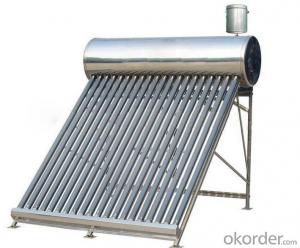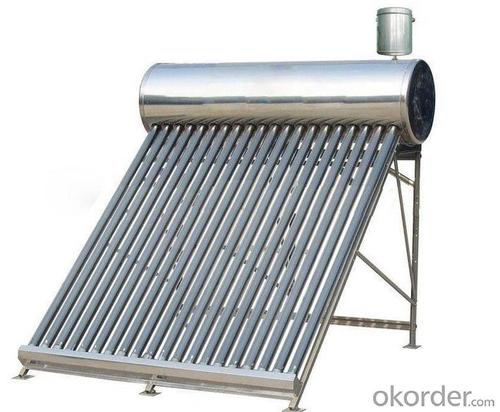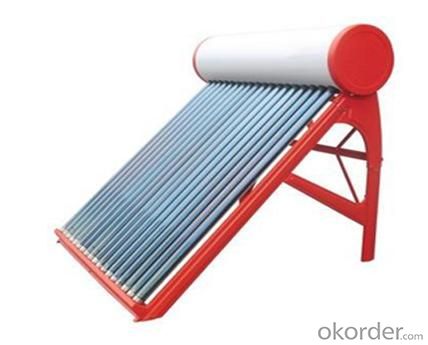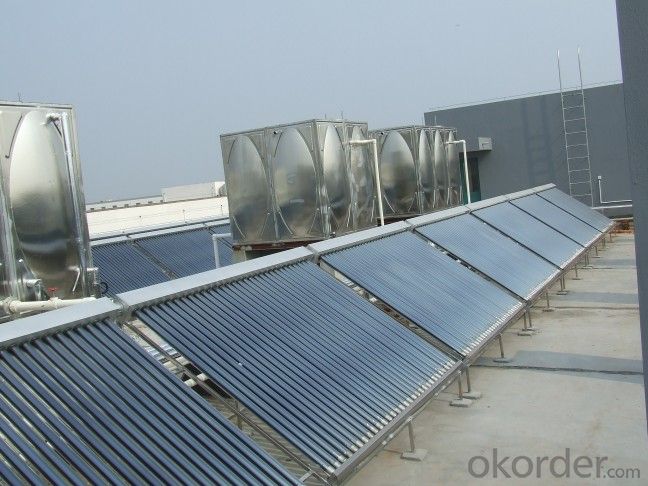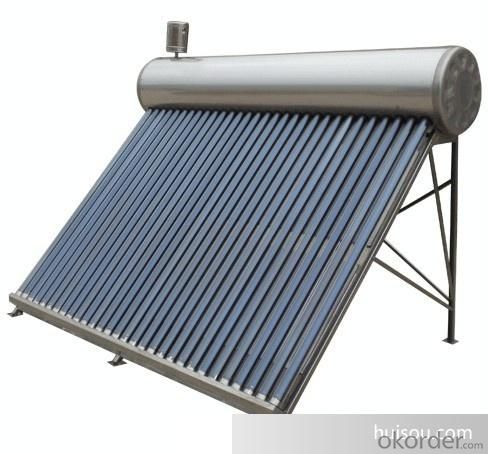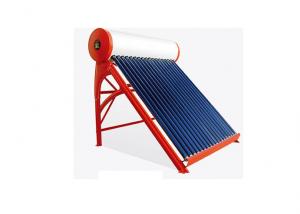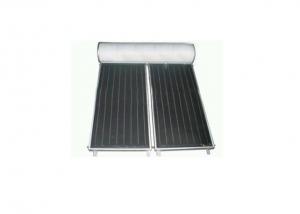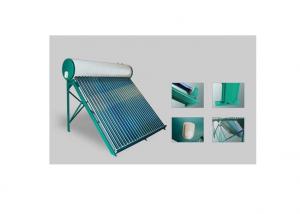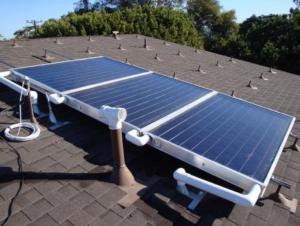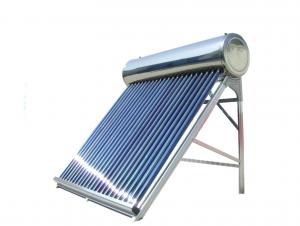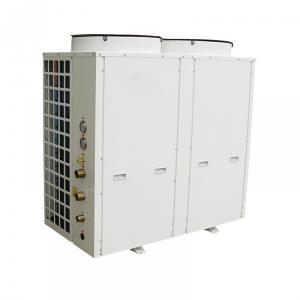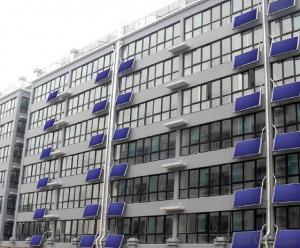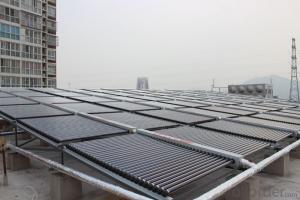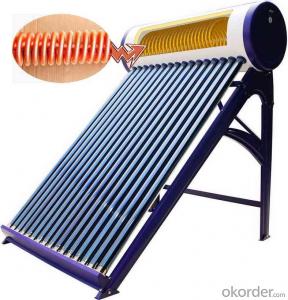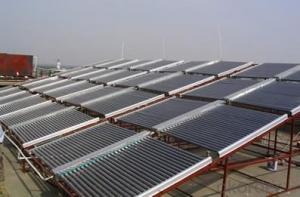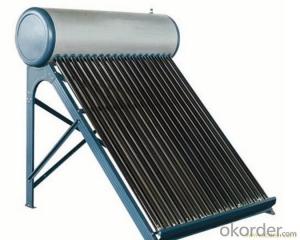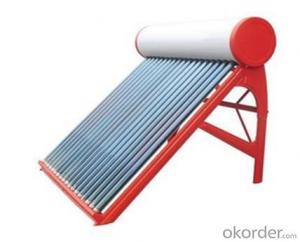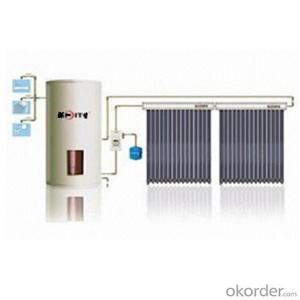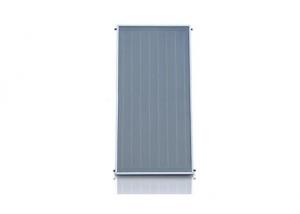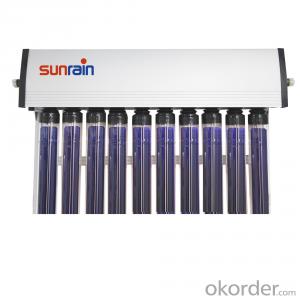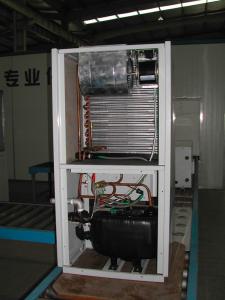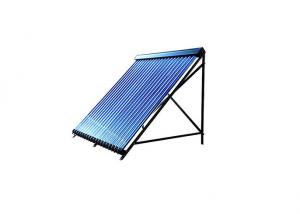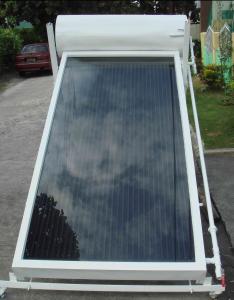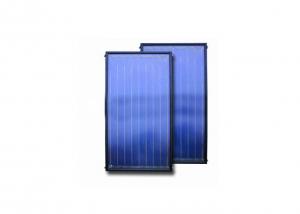Sunearth Solar Water Heater with Copper Coil in Water Tank
- Loading Port:
- China main port
- Payment Terms:
- TT OR LC
- Min Order Qty:
- 1 set
- Supply Capability:
- 6000 set/month
OKorder Service Pledge
OKorder Financial Service
You Might Also Like
Introduction of Non-Pressure Solar Water Heater:
Non-pressure Solar Heater is one of the most economical solar water heating device with pretty high efficiency at the same time. It consists of hot water storage tank, solar vacuum tubes with mouth plug in storage tank, and bracket supporting tank and tubes.When cold water in evacuated tubes is heated with solar irradiation, as the specific gravities of hot water and cold water are different, hotter water goes upward to storage tank and colder water goes downward to glass tubes. through this continuous circulation, the cold water in storage tank will be gradually heated till sunset.
Specialty:
1. High thermal performance and working temperature: the heat exchanging rate even in winter can up above 55%.
2. Heat collecting efficiency is at least 20% above common solar systems.
3. Work in all day and all season: no matter any corner of the world, this system can work well even -40℃ to avoid the tube freezing problem.
4. Reliability: No water following through the tube, so water scale can not generate and tube cracks could be avoided, the system still can keep working even with some damaged tubes.
5. It can connect with water tap and work automatically with pressure0.6Mpa, bring enjoyable washing experience.
6. Safety: P/T valve would release pressure and temperature to protect tank..
Technical Specification:
1. Outer tank material: SUS304 stainless steel or powder coated color steel
2. Inner tank material: 1.2mm thick SUS304 food grade stainless steel ( Optional material SUS316L)
3. Vacuum tube material: borosilicate glass 3.3; AL-SS-CU absorb coating, with copper heat pipe inside
4. Frame material: 1.2mm thickness stainless steel
5. Insulation material: 55mm thickness polyurethane
6. Suitable for mains pressure water(up to 8 bar/116psi)
7. Easy plug-in installation
8. Install the T/P valve on the pressurized tank
9. Seal material: Stabilized High Temperature Silicon
Outer tank material: SUS304 stainless steel or powder coated color steel
Inner tank material: 1.2mm thick SUS304 food grade stainless steel ( Optional material SUS316L)
Vacuum tube material: borosilicate glass 3.3; AL-SS-CU absorb coating, with copper heat pipe inside
Frame material: 1.2mm thickness stainless steel
Insulation material: 55mm thickness polyurethane
Suitable for mains pressure water(up to 8 bar/116psi)
Easy plug-in installation
Install the T/P valve on the pressurized tank
Seal material: Stabilized High Temperature Silicon
19. Vacuum Tube | 20. Size (mm) | 21. Φ47*1500 / Φ58*1800 / Φ70*2100 | |||||
22. Tube (pcs) | 23. 10 / 12 / 15 / 18 / 20 / 22 / 24 / 30 / 36 / 42 | ||||||
24. Material | 25. Borosilicate 3.3 glass, magnetron spluttering selective coating | ||||||
26. Coating | 27. Single-target AL-N/AL or Three-target AL/N-Cu-SS | ||||||
28. Water Tank | 29. Capacity | 30. 80L ~ 500L for hot water storage tank | |||||
31. Inner tank | 32. Food-grade stainless steel SUS304-2B / SUS316 | ||||||
33. Insulation | 34. High-density polyurethane foam with 70~80 hour heat preservation | ||||||
35. Tank shell | 36. Food-grade stainless steel SUS304-2B | ||||||
37. Bracket | 38. Shaped strong aluminum alloy structure adaptable for flat or slope roof | ||||||
39. Accessories | 40. Anti-aging silicon seals, Dustproof seals, Air-vent cap, Stainless screws | ||||||
41. Auxiliary Devices | 42. Assistant tank, Intelligent controller, Electrical heater, Magnesium anodes | ||||||
43. Tilt Angle | 44. 25 ~ 50° | ||||||
45. Water Output | 46. 45 - 95°C | ||||||
47. Hail Resistance | 48. Φ25mm diameter | ||||||
49. Model Number | 50. Solar Vacuum Tube | 51. Tank 52. Liter | 53. System 54. Liter | 55. Container Loading Qty /sets | |||
56. Size /mm | 57. Qty /pcs | 58. 20GP | 59. 40GP | 60. 40HQ | |||
61. VNS-58SA12-100 | 62. Φ58*1800 | 63. 12 | 64. 100 | 65. 132 | 66. 58 | 67. 119 | 68. 140 |
69. VNS-58SA15-130 | 70. 15 | 71. 130 | 72. 170 | 73. 54 | 74. 108 | 75. 131 | |
76. VNS-58SA18-150 | 77. 18 | 78. 150 | 79. 198 | 80. 43 | 81. 86 | 82. 105 | |
83. VNS-58SA20-170 | 84. 20 | 85. 170 | 86. 223 | 87. 40 | 88. 80 | 89. 97 | |
VNS-58SA24-200 | 24 | 200 | 263 | 35 | 70 | 85 | |
VNS-58SA30-250 | 30 | 250 | 329 | 28 | 56 | 68 | |
VNS-58SA36-300 | 36 | 300 | 395 | 23 | 47 | 57 | |
Products Show
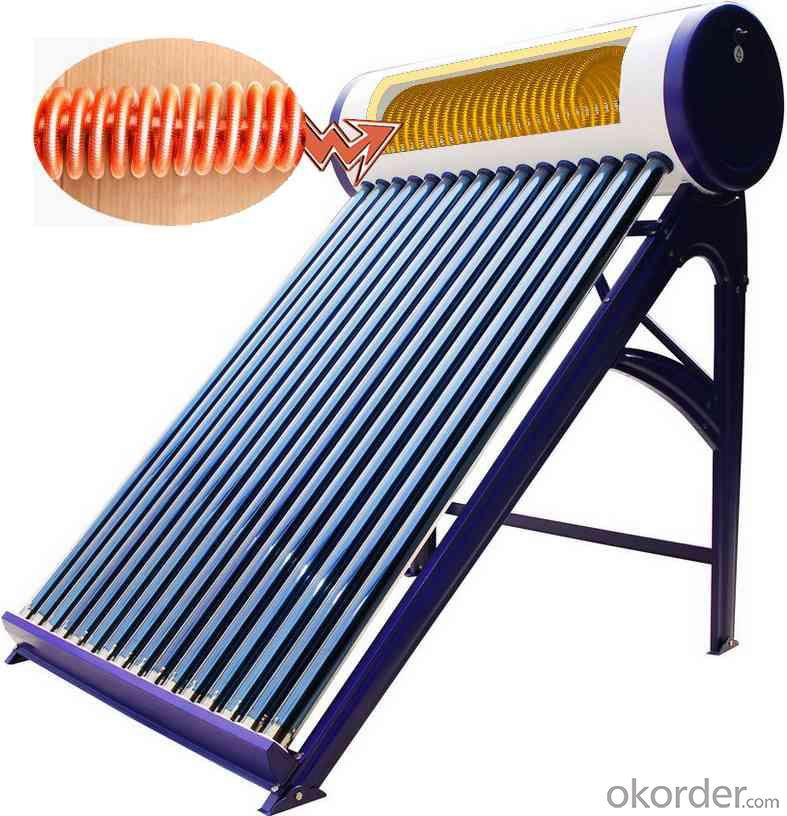
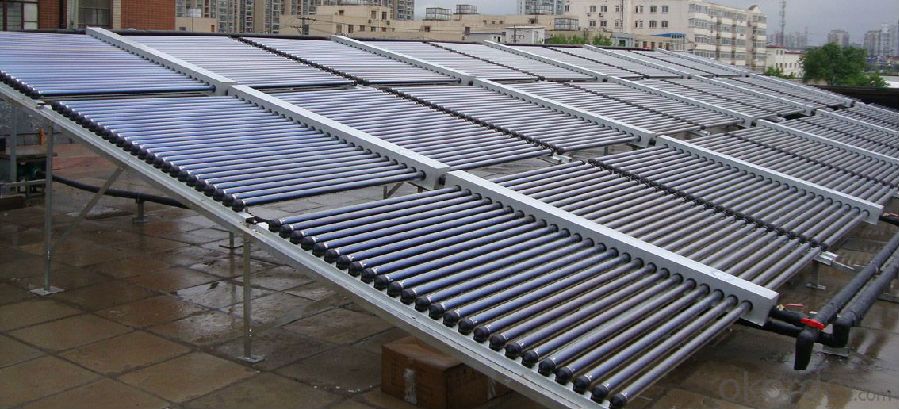
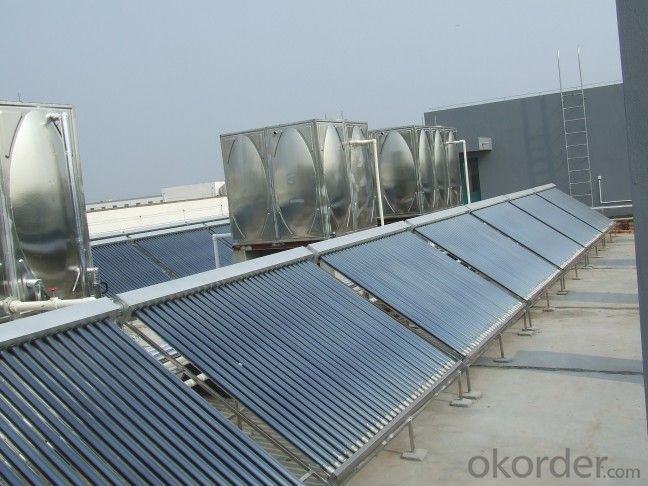
Our Services
1. OEM service
2. Warranty: 5 years
3. Considerable after sale service
Color steel Compact pressure Thermal solar heater
FAQ:
1. What’s the delivery time?
10 days after receiving deposit.
2. How long is the warranty?
5 years for whole system, 1 year for accessory
3. What’s your production capacity?
6000sets/month
4. What’s the MOQ?
1 set.
5. What’s your payment term?
Container: 30% T/T in advance for deposit, 70% T/T before shipment for fist order.
70% T/T after seeing copy of B/L from second order
Sample: 100% T/T in advance
Other choices: L/C at sight.
6. What certifications do you have?
CE, SOLAR KEYMARK, SRCC and etc.
- Q: Can a solar water heater be used in areas with limited access to internet connectivity?
- Yes, a solar water heater can be used in areas with limited access to internet connectivity. The functioning of a solar water heater does not depend on internet connectivity as it uses solar energy to heat the water. The system operates independently without the need for internet access, making it suitable for areas with limited connectivity.
- Q: Can a solar water heater be used in areas with limited access to technological advancements?
- Yes, a solar water heater can be used in areas with limited access to technological advancements. Solar water heaters are relatively simple and low-tech devices that use the sun's energy to heat water. They are independent of electrical grids or complex infrastructure, making them suitable for areas with limited access to technology. Additionally, solar water heaters are often more affordable and sustainable alternatives to conventional water heating methods in such areas.
- Q: What is the average cost of installing a solar water heater?
- The average cost of installing a solar water heater can vary depending on various factors such as the size and type of the system, location, and any additional installation requirements. However, on average, the cost can range from $5,000 to $10,000, including equipment and installation expenses.
- Q: Can a solar water heater be used in areas with limited water supply?
- Yes, a solar water heater can be used in areas with limited water supply. Solar water heaters use the energy from the sun to heat water, and they do not require a continuous flow of water to function. They can be designed with storage tanks, allowing water to be heated during periods of water availability and used when needed, making them suitable for areas with limited water supply.
- Q: What are the benefits of using a solar water heater?
- There are several benefits of using a solar water heater. Firstly, it reduces energy consumption and lowers utility bills, as solar energy is free and abundant. Secondly, it helps to reduce carbon emissions and is environmentally friendly since it does not rely on fossil fuels. Additionally, solar water heaters require minimal maintenance and have a long lifespan, making them a cost-effective choice in the long run. Finally, using a solar water heater can also qualify for various government incentives and rebates, further adding to the overall savings.
- Q: Can a solar water heater be used in areas with limited access to energy consultants?
- Yes, a solar water heater can be used in areas with limited access to energy consultants. Solar water heaters are relatively simple and reliable systems that can be installed with basic knowledge and understanding of solar technology. Many manufacturers provide detailed installation manuals and technical support to assist users in setting up and maintaining their solar water heaters. Additionally, there are various online resources, tutorials, and forums available that can guide individuals through the installation process.
- Q: What is the lifespan of a solar water heater?
- The lifespan of a solar water heater typically ranges between 20 to 30 years.
- Q: Are there any safety concerns associated with using a solar water heater?
- Yes, there are a few safety concerns associated with using a solar water heater. One potential concern is the risk of overheating, which can result in scalding water or even damage to the system. Additionally, there is a risk of freezing in colder climates if the system is not properly designed or protected. It is important to ensure proper installation, regular maintenance, and adherence to safety guidelines to mitigate these risks.
- Q: Can a solar water heater be used in areas with limited access to sunlight?
- No, a solar water heater requires ample sunlight to effectively heat water, so areas with limited access to sunlight would not be suitable for its use.
- Q: Can a solar water heater be used in areas with limited access to educational resources?
- Yes, a solar water heater can be used in areas with limited access to educational resources. Solar water heaters are relatively simple and do not require advanced technical knowledge to operate. Basic instructions and training can be provided to the local community, empowering them to install and maintain the system. Additionally, solar water heaters have proven to be cost-effective and environmentally friendly, making them a viable option for areas with limited resources.
Send your message to us
Sunearth Solar Water Heater with Copper Coil in Water Tank
- Loading Port:
- China main port
- Payment Terms:
- TT OR LC
- Min Order Qty:
- 1 set
- Supply Capability:
- 6000 set/month
OKorder Service Pledge
OKorder Financial Service
Similar products
Hot products
Hot Searches
Related keywords
